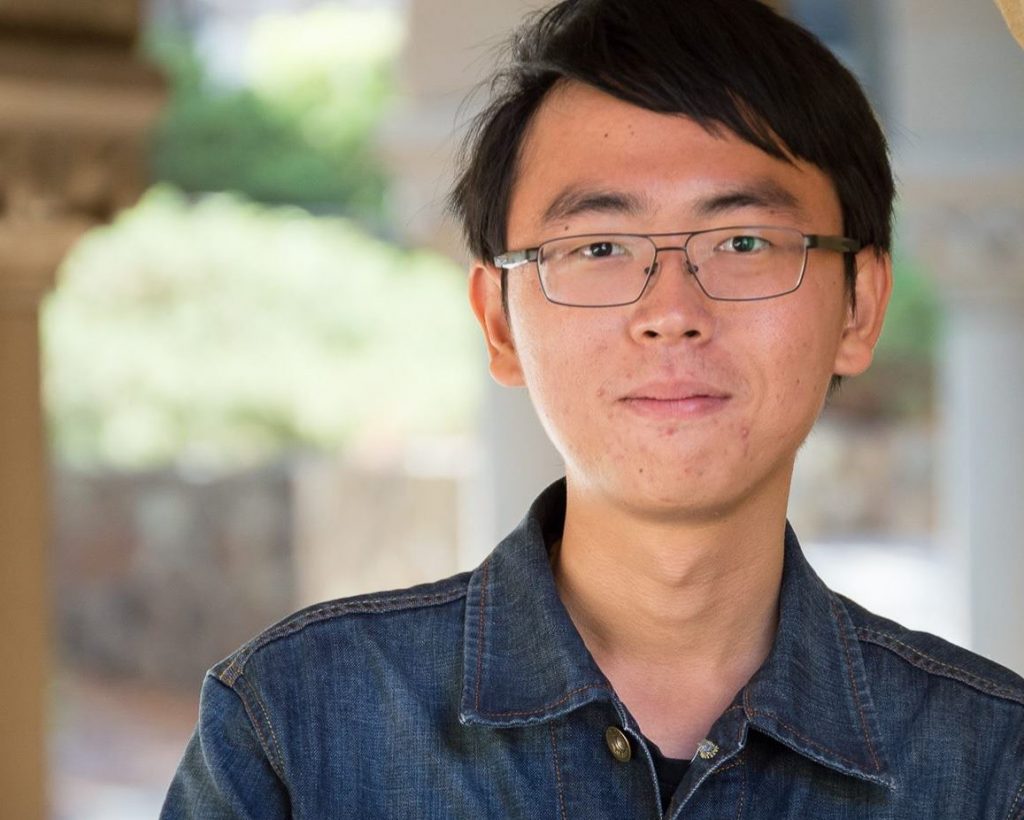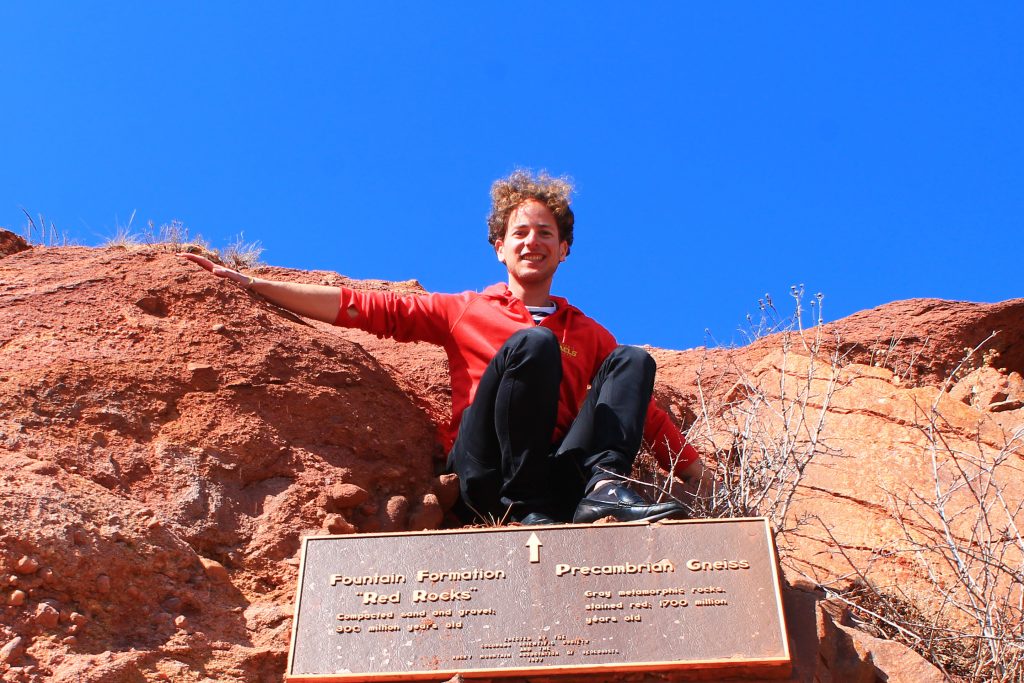In March this year, students from the University of Texas Jackson School of Geosciences presented research at the annual meeting of the UT-Austin EDGER Forum, an industry consortium that sponsors education and research in exploration geophysics. Research carried out by the group spans laboratory experiments, numerical simulations and field data analysis, a combination that is virtually unheard of among geophysics consortia and frequently leads to applications in industry.
We met with students from each of the consortium’s three research tracks: numerical simulations, theoretical rock physics and laboratory experiments. In the final part of our UT EDGER Forum student stories, we met Ken Ikeda and Eric Goldfarb, PhD students working with Dr. Nicola Tisato’s rock physics research group at the Jackson School’s Rock Deformation Lab. EDGER Forum Co-Investigator, Nicola Tisato, is assistant professor at the Department of Geological Sciences, Jackson School of Geosciences.
KEN IKEDA

Ken Ikeda first became interested in rock physics after joining a summer research program at Stanford University where he had the opportunity to work with renowned professor, Gary Mavko.
“I did this summer research program in 2016, after I graduated from Chulalongkorn University (in Thailand),” says Ken. “The program is called Stanford’s Summer Undergraduate Research in Geoscience and Engineering (SURGE) and what we did there is try to understand the elastic properties of rocks from 2D slices. That got me interested in rock physics and this is how I ended up studying geophysics with Nicola (Tisato).”
When it was time to choose a PhD program, Ken was attracted by experimental geophysics opportunities offered by programs at the Jackson School.
“When I was a high school student I loved doing electronics, so when I learned about Nicola’s work and what they’re doing with experimental rock physics I thought it might be fun!”
Now in the third year of his PhD, Ken’s research encompasses two approaches to geophysics: experimental and digital rock physics. As an experimental rock physicist, Ken conducts lab experiments to see how seismic energy attenuates under different conditions, in other words how things like density, pressure, the presence of fluids, temperature and even rock alignment can distort the shape of seismic waves as they move through the earth. This is useful to industry members of the EDGER Forum because it helps them use seismic data to make sense of geologic conditions deep underground. Ken says that his research has a wide range of applications outside of oil and gas exploration, including the study of earthquakes, groundwater, and more recent technologies such as the safe underground storage of nuclear waste or carbon dioxide.
As a digital rock physicist, Ken uses X-ray Computed Tomography (or CT) to scan and digitize rocks. Creating digital models of rocks allows scientists to conduct all manner of tests without destroying or damaging them. Ken points out that this is especially important when studying rare or expensive rocks.
“The other reason,” he adds, “is that, in the era of digital transformation, it’s a digital file so once you’ve uploaded it you can share it and get real collaboration across the world.”
Ken is impressed with UT’s collaborative culture and the resources academic consortia such as the UT EDGER Forum can leverage. “The thing we get here at UT is really good collaboration between world leading professors,” he explains, “Nicola is an expert in experimental rock physics, Kyle (Spikes) is an expert in theoretical rock physics, and Mrinal (Sen) is an expert at inversion. So, in EDGER Forum we have this very good army of people working together to understand the subsurface and how to interpret it.”
Ken believes it important to promote such thinking across the science community and this year became president of the Texas Geophysical Society, a student chapter of the Society for Exploration Geophysicists dedicated to fostering communication and collaboration among geophysicists students at UT.
As a real hub of collaboration, Ken acknowledges that UT is a great university with many research opportunities and in his words, ‘awesome’ facilities. But for Ken, UT is more than just buildings and research opportunities.
“People in Texas are really, really friendly,” he explains. “I’ve lived in a few places in the US, but I feel that in Austin people are really the friendliest and they’re always willing to help.”
ERIC GOLDFARB

Eric Goldfarb decided to become a geoscientist because he wanted to find out why things in the natural world look the way they do. Having worked in civil engineering, as a ski instructor, a bicycle courier and even as a member of a national sailing team, Eric finally embarked on a Ph.D. program at UT Jackson School of Geosciences, where he now works with Nicola Tisato creating digital reconstructions of rocks and performing sophisticated physics experiments at the school’s newly constructed rock deformation lab.
The lab’s pressure vessel allows Eric to perform tests on rocks and fluids under the extreme conditions in which they are found deep underground.
“We’re really the first to do this kind of testing at confined pressure,” explains Eric. “What we do is place sensors in a rock with some fluid in it, then squeeze the rock to see how the fluid moves.”
This sort of experimental rock physics helps scientists understand how fluids, such as oil, move through rock deep underground. Closer to the surface, similar principles can be applied to underground drinking water reservoirs.
“Texas, suffers from water scarcity issues,” says Eric, “so, figuring out the permeability of groundwater reservoirs and what controls the way water flows through the rock is important for water management.”
Whether mining, drilling for oil, constructing a tunnel or looking for groundwater, geologists need to create models of the subsurface. The other half of Eric’s research therefore centers on creating digital reconstructions of rocks using techniques similar to those used in hospitals to study the human body.
“Recording a certain signal doesn’t tell us much unless we can interpret it,” says Eric, “and the way we do that is to analyze samples in the lab. We also have been using CT scanning, similar to the technology used in hospitals, which allows us to make numerical models without cutting the rock open.”
Although Eric’s work with the EDGER Forum receives support from the oil and gas industry he has recently found a particularly exciting use for the techniques he is developing.
“I’m actually about to scan a Martian meteorite,” he tells me.
Pieces of the Red Planet can end up on Earth when an impact on Mars is large enough to blast material into space. Eventually, some of that material may find its way to Earth.
“These samples are rare so we can’t really cut them open and do the same kind of invasive conventional tests we usually do,” explains Eric, “which is why we’re going to CT scan it and numerically simulate lots of non-invasive tests.”
Eric goes on to explain that understanding how seismic waves travel through the Martian soil will be critical if scientists are to make any sense of information from NASA’s InSight mission, which is currently on Mars.
“When you only have one sensor picking up a signal it’s almost useless,” said Eric, referring to the lander’s solitary seismometer. “But if we can model how seismic waves travel through Martian soil it can tell us a lot more about what we’re seeing.”
By understanding the physics of Martian rocks, when the lander records seismic signals such as meteor impacts or Mars-quakes, scientists should be able to make inferences about the composition of Mars’s interior.
The opportunity to apply his knowledge to planetary geology alongside oil and gas and groundwater management is a variety of experience that Eric has found nowhere else.
“Geoscience is so broad it covers everything from the individual nanometer parts that make one thing, to dinosaurs, to space, oil, energy, mining, it’s really everything,” he says.
Eric said that UT offers the depth of experience to keep him motivated and stimulate his imagination and curiosity.
“I like doing what I do,” he said. “I like coding on the computer and tackling logic problems in lots of different ways. I also like that I can go on a big field trip, study something amazing and see more of the world.”
Last semester Eric travelled to Morocco to learn how the Atlas Mountains formed. The semester before, he was canoeing down the Pecos River, studying the geological history of Texas.
“What I like at this school is that if there’s an area I haven’t yet studied, I know that every day there’s a lecture where I can learn about, for example, the mantle, or I can hear what people are doing who study chemistry and physics,” he added.
“I like being free to ask questions and I like being able to find out answers, because I like knowing how things work.”
